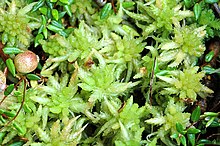Sphagnum palustre
| Sphagnum palustre | |
|---|---|

| |
| Scientific classification | |
| Kingdom: | Plantae |
| Division: | Bryophyta |
| Class: | Sphagnopsida |
| Subclass: | Sphagnidae
|
| Order: | Sphagnales |
| Family: | Sphagnaceae |
| Genus: | Sphagnum |
| Species: | S. palustre
|
| Binomial name | |
| Sphagnum palustre L. , 1753 | |
Sphagnum palustre (Syn. Sphagnum cymbifolium), the prairie sphagnum[1] or blunt-leaved bogmoss,[2] is a species of peat moss from the genus Sphagnum, in the family Sphagnaceae. Like other mosses of this type it can soak up water up to the 30-fold amount of its own dry weight thanks to its elastic spiral fibers. S. palustre is rather frequent and is spread almost all over the world. It mainly grows in wet forests and—compared to other specimens of this genus—rarely grows in moors.
Traits

Sphagnum palustre forms firm plants up to 25 centimeter height. The plants are often light green to light brown with stem diameters of 0.6 to 1.2 millimeters. The epidermis (Hyalodermis) of the stem is built in three layers and their cells form 1 to 3 seldom more pores and contain much spiral fibers. The branches are tufted forming clusters of three to six on the little stems. The heads are a little more pigmented and egg-shaped.
Distribution
Sphagnum palustre plants are spread across the whole of Europe and also can be found in parts of America, Australia and New Zealand. It is comparatively frequent and grows on moist and wet habitats like wet forests, often coniferous forests, on marshy meadows, but rarely in moors. The species often forms large carpets, sometimes bulge-shaped. It is often accompanied by Sphagnum fimbriatum, Sphagnum subnitens, and Sphagnum squarrosum.
Sphagnum palustre is invading the native habitat at
British distribution
Sphagnum palustre is found all over the
Threat
Sphagnum palustre is not on the
Uses
In a project called
References
- ^ USDA, NRCS (n.d.). "Sphagnum palustre". The PLANTS Database (plants.usda.gov). Greensboro, North Carolina: National Plant Data Team. Retrieved 25 November 2015.
- ISSN 0268-8034.
- University of Hawaii at Manoa. Technical Report, 192 – via ResearchGate.
- ^ FUKUTA, E., SASAKI, A., & NAKATSUBO, T. (2012). Microclimate and production of peat moss Sphagnum palustre L. in the warm‐temperate zone. Plant Species Biology, 27(1), 110–118. https://doi.org/10.1111/j.1442-1984.2011.00357.x
- ISBN 978-0956131010. Retrieved 13 April 2015.
- ^ Video from Euronews “Biotechnology to fight air pollution” Euronews June 3, 2013 retrieved December 4, 2013
- ^ Website of the research project
